Hydraulic Presses
A hydraulic press is a compression molding press machine that uses hydraulic pressure, or fluid pressure, via a cylinder, in order to exert force on an object. Presses are named as such because they press down onto a substrate and die in order to stamp it.
Hydraulic presses rely on Pascal's principle that the pressure throughout a closed system will act with equal force on all areas. As both the most common and most efficient type of industrial press, hydraulic presses apply a large lifting or compressing force that cannot be achieved using pneumatic presses or mechanical presses.
Quick links to Hydraulic Presses Information
Applications of Hydraulic Presses
Hydraulic presses are produced so that manufacturers can stamp metal material into different finished parts. They may also perform other metal forming processes, such as clinching, forging, punching, shearing, molding, deep drawing and blanking.
Some of the industries that rely the most on hydraulic press services include: automotive manufacturing, packaging, appliance (ex. parts of microwaves, dishwashers, refrigerators, etc.), ceramics, aerospace engineering, military and defense, food and beverage processing, pulp and paper, and marine.
Among the most common hydraulic press applications are beverage can fabrication and automotive parts fabrication.
The History of the Hydraulic Press
The hydraulic press was invented in England in 1795 by Joseph Bramah, who was led to the study of fluids after he developed the flush toilet. For this reason, hydraulic presses are sometimes known as Bramah presses. He based his invention on the concept known as the Pascal principle, or the Pascal law, which maintains that pressure throughout a closed system is constant.
Bramah invented the hydraulic press at a time in which there was very little like it. In this way, he blazed the trail for hydraulic engineers after him. Those who have followed this trail have since invented dozens of variations on Bramah’s original model.
Benefits of a Hydraulic Press
The force achieved with hydraulic presses is unparalleled; the same force cannot be achieved with either mechanical or pneumatic presses. These are not, however, the only advantages of hydraulic presses. Others include:
- Low Upfront Investment and Operating Cost
- Since hydraulic presses are simple and have few moving parts, they are inexpensive to purchase and easy to maintain and troubleshoot, especially in comparison to other available options. If any parts break down, they can be replaced easily without tearing down the machine apart. Moreover, hydraulic equipment and supplies can be easily available globally, which for you means low downtime and low maintenance costs.
- Operation of Power Stroke
- Unlike presses that deliver full power only from the bottom, hydraulic presses can relay full power at any point in the stroke. This eliminates the need to buy an unnecessarily heavy press, such as the 200-ton press, just to deliver a lower force, like 100 tons, throughout the stroke. This advantage is especially helpful in drawing operations.
- Easy Operation and Built-in Protection
- A hydraulic press designed to exert 100 tons, or less, will exert that much pressure irrespective of mistakes one makes in setting it up. In that respect, it’s foolproof. Also, as an operator, you do not need to fret about overloading, smashing a die and breaking the press. These presses are designed in such a way that when a hydraulic press reaches its set pressure, it opens the relief valve at that limit; therefore, there is no danger of overload.
- Control and Flexibility
- You can control and adjust many things in a hydraulic press according to need. Examples include: duration of pressure dwell, the direction, ram force, the speed, and the release of force.
- Lower Operation Noise
- Since hydraulic presses have neither flying wheels nor many moving parts, they make a lot less noise than mechanical presses. In fact, present day hydraulic presses with a properly mounted pumping unit exceed the current federal standards for noise regulation.
- Long Machine Tool Life
- The built-in overload protection also serves well to tools. As the pressure is always the same, there is no danger of damaging tools with overloading. The lack of shock, vibration and impact help auxiliary equipment, such as press brakes and machine guards, to last longer.
How Hydraulic Presses Works
A hydraulic press starts working when hydraulic fluid is forced into a small double-acting cylinder (the slave cylinder) by a hydraulic pump or a lever. Inside this hydraulic cylinder is a sliding piston, which acts as a compressive force on the fluid. It thrusts it through a pipe into a larger cylinder (the master cylinder), where the fluid is compressed once more with a larger piston. The larger piston forces the fluid back into the smaller cylinder. As the fluid is passed back and forth, the pressure builds until it is so great that it can make contact with and press the anvil, baseplate, or die. When it does so, it deforms the material into the desired product shape.
To stop overload, once the preset pressure is achieved, the fluid then activates a valve, which activates pressure reversal. With this press design, there is no need for a sophisticated guiding system, as the die tends to guide the press itself.
Hydraulic Press Images, Diagrams and Visual Concepts
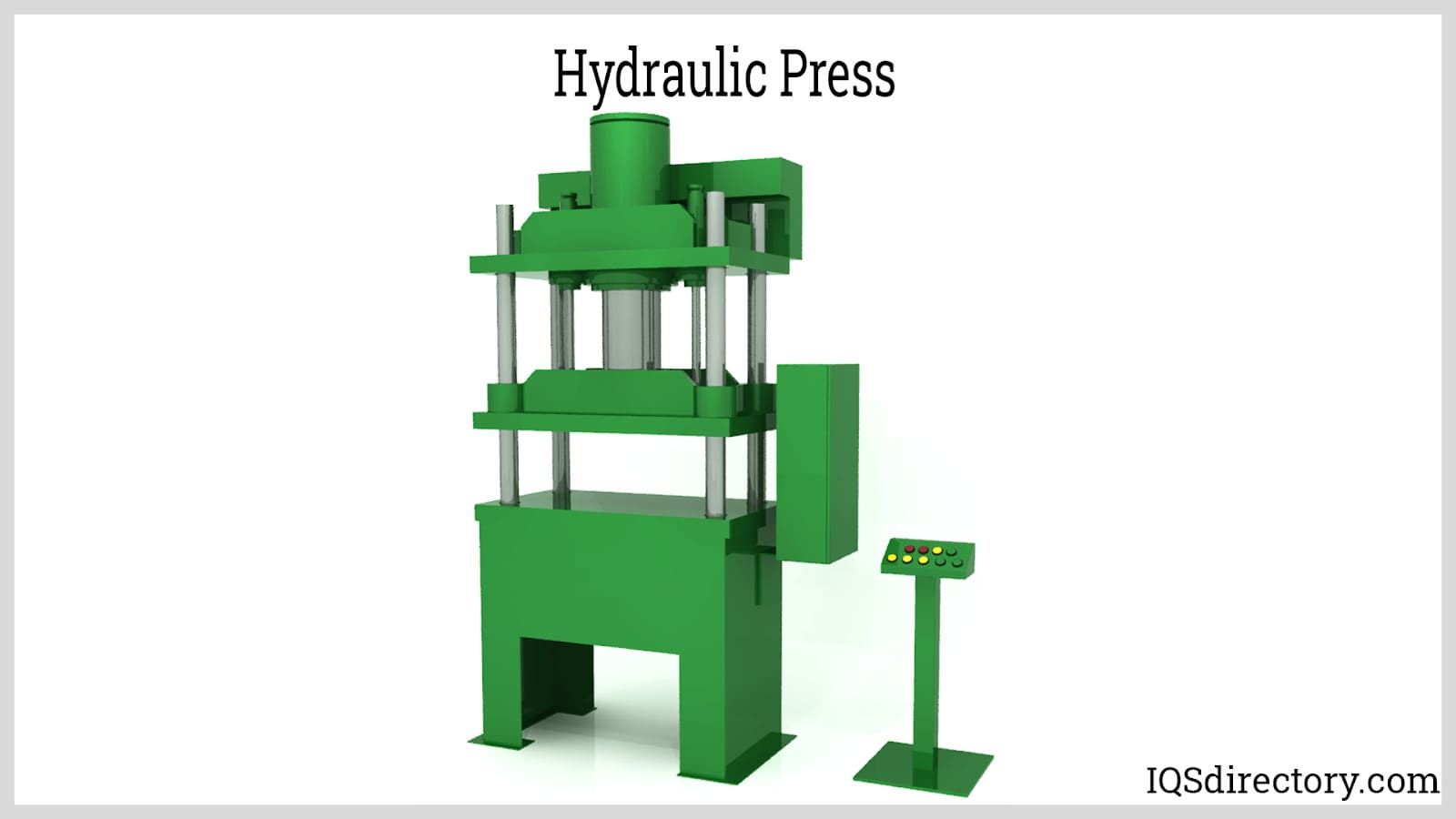 hydraulic press uses liquid static pressure to configure different materials into different shapes.
hydraulic press uses liquid static pressure to configure different materials into different shapes.
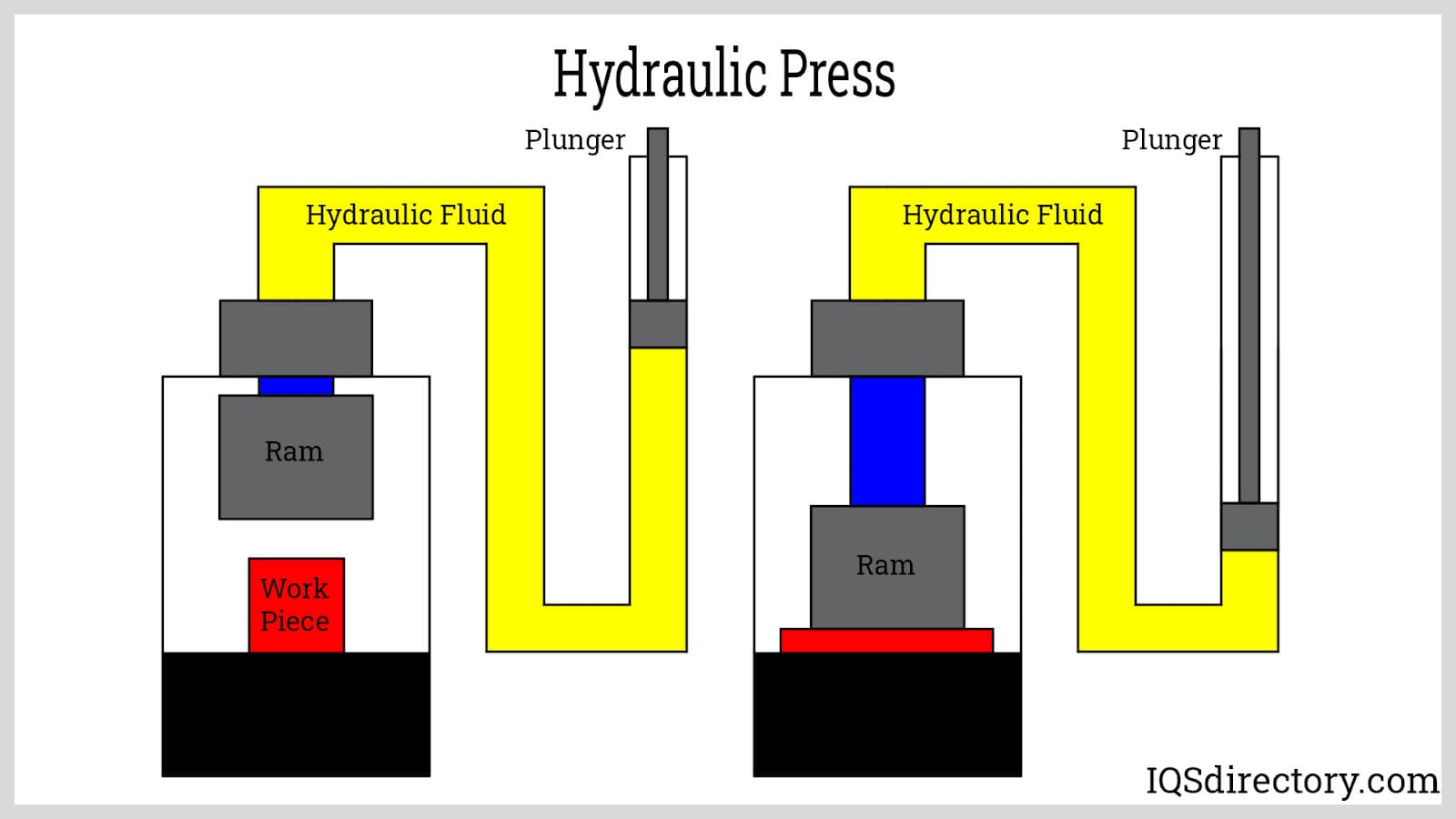 The hydraulic press uses the plunger displaces the fluid and extends the ram to shape the material.
The hydraulic press uses the plunger displaces the fluid and extends the ram to shape the material.
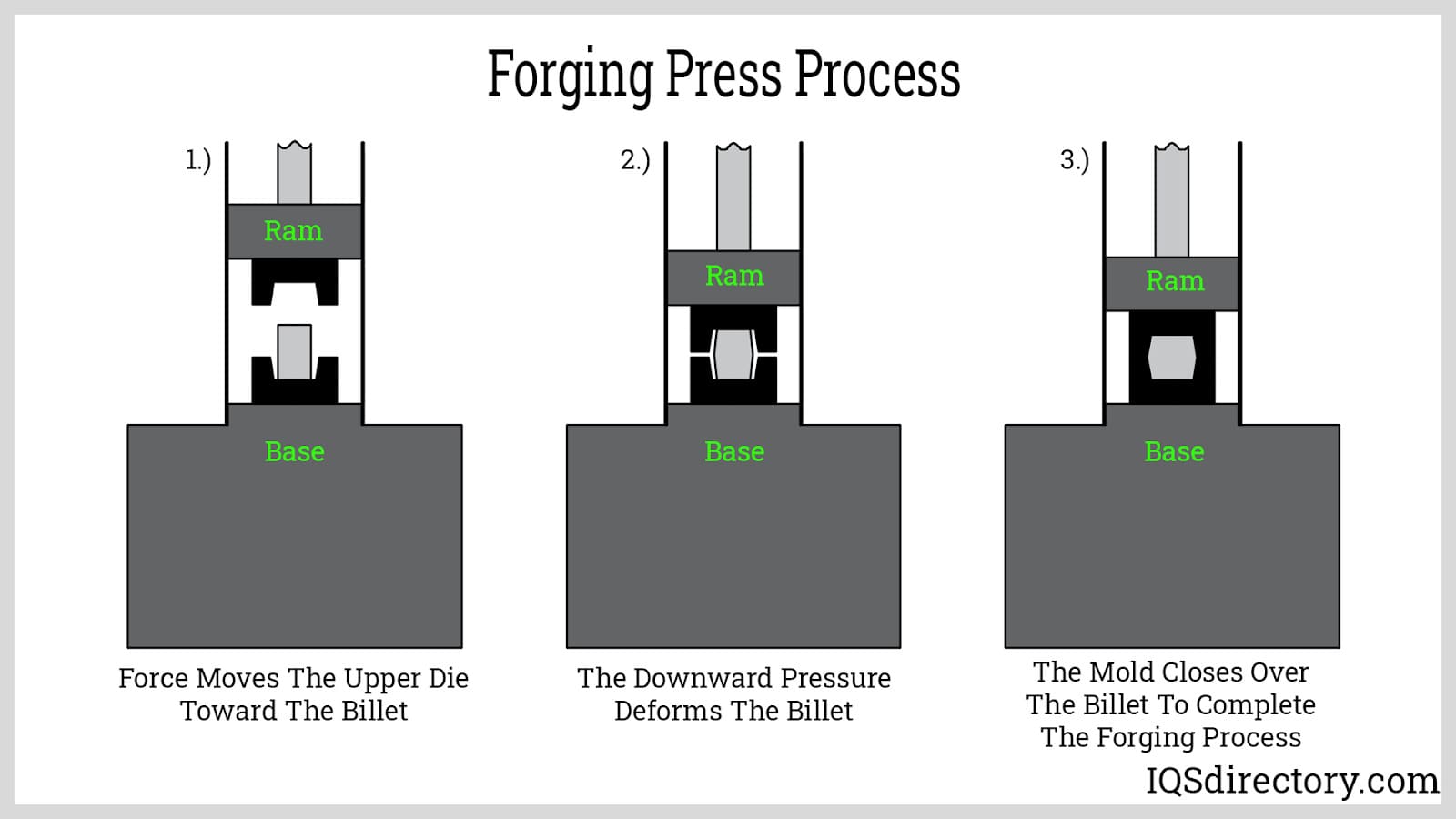 Forging presses use a vertical ram to apply gradual, controlled pressure to the workpiece inside a die.
Forging presses use a vertical ram to apply gradual, controlled pressure to the workpiece inside a die.
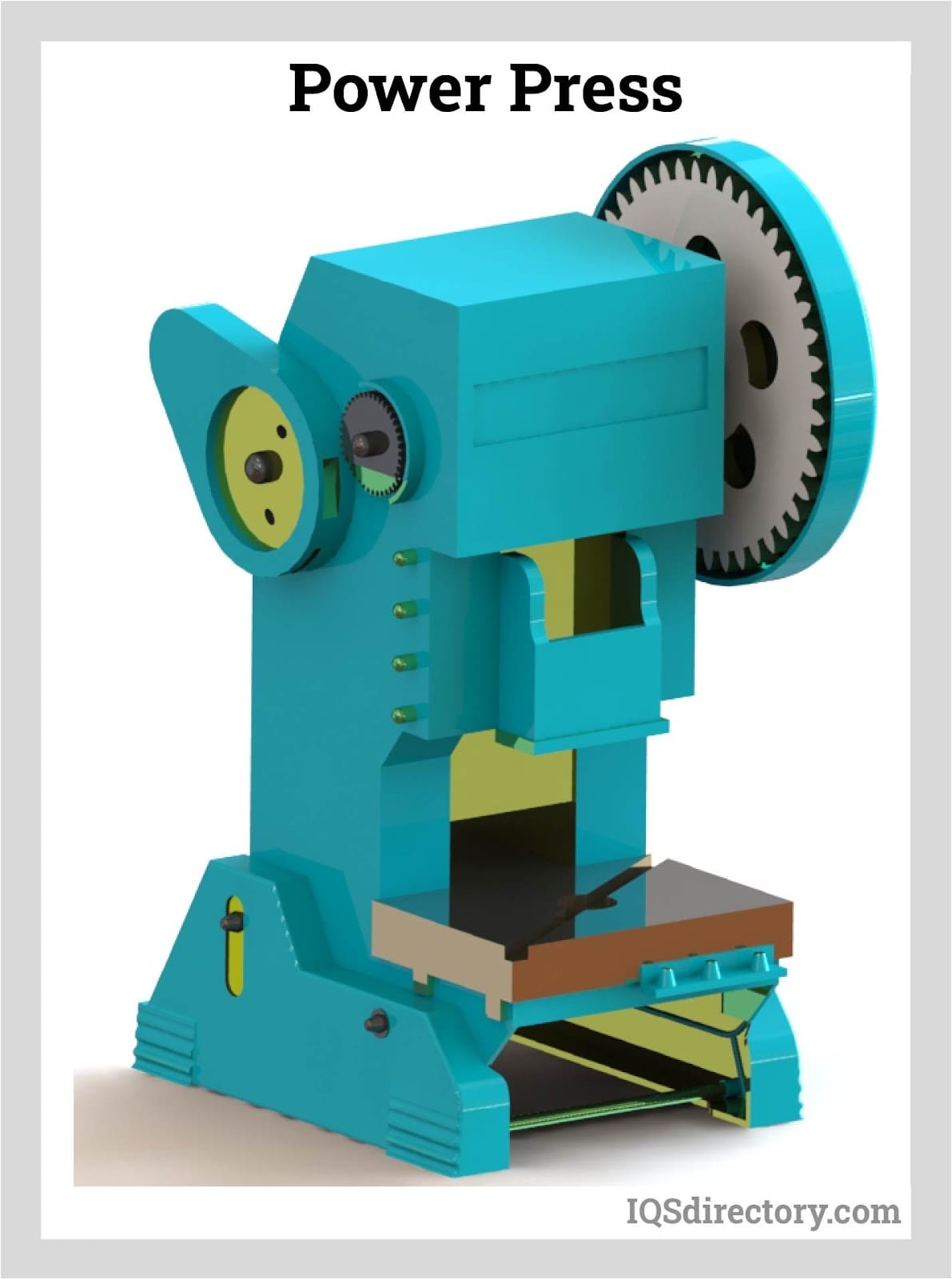 Power presses cut or shape any type of sheet metal to the required shape.
Power presses cut or shape any type of sheet metal to the required shape.
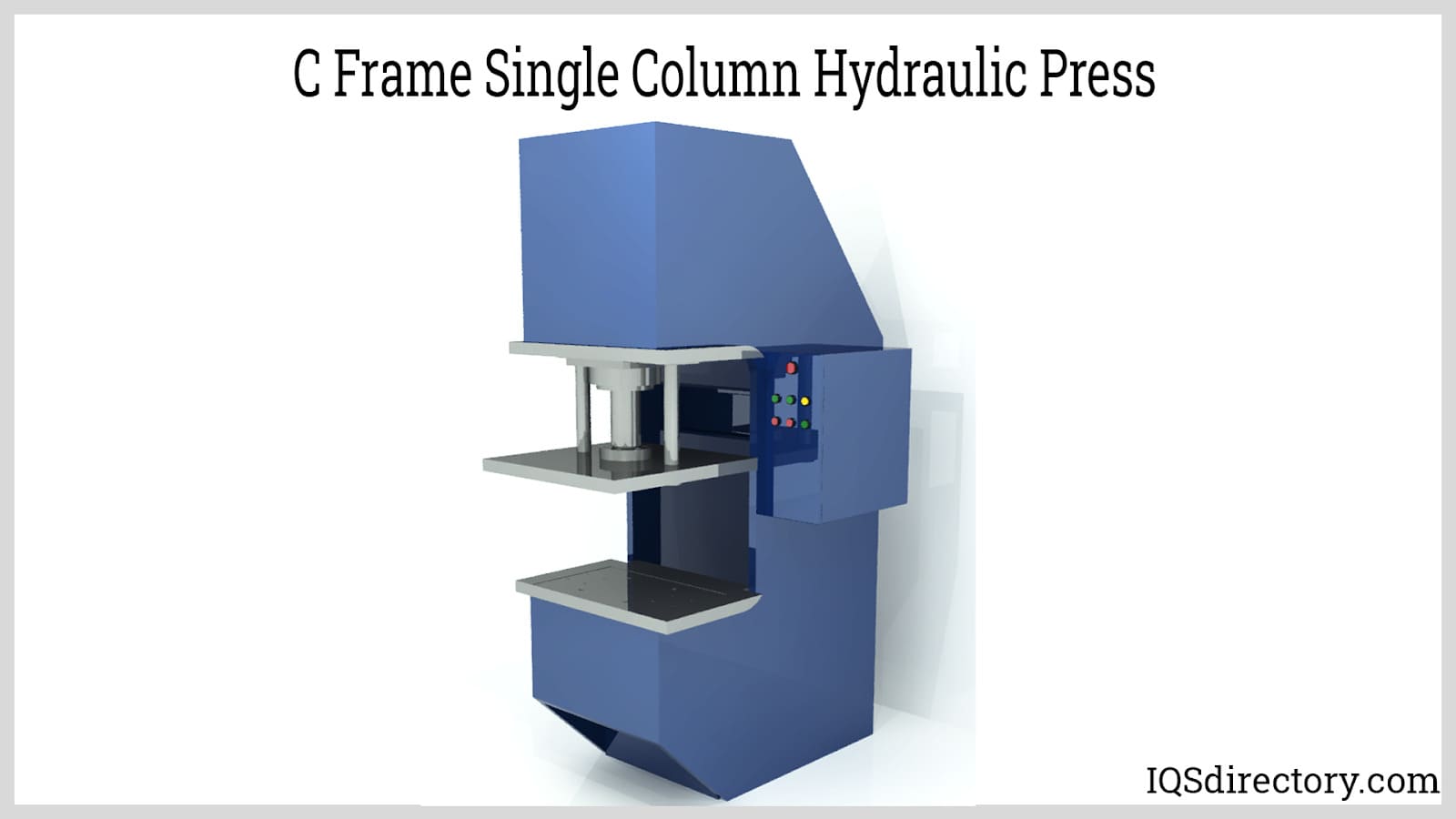 Single column C frame hydraulic presses have excellent rigidity, guide performance, speed, and exceptional precision.
Single column C frame hydraulic presses have excellent rigidity, guide performance, speed, and exceptional precision.
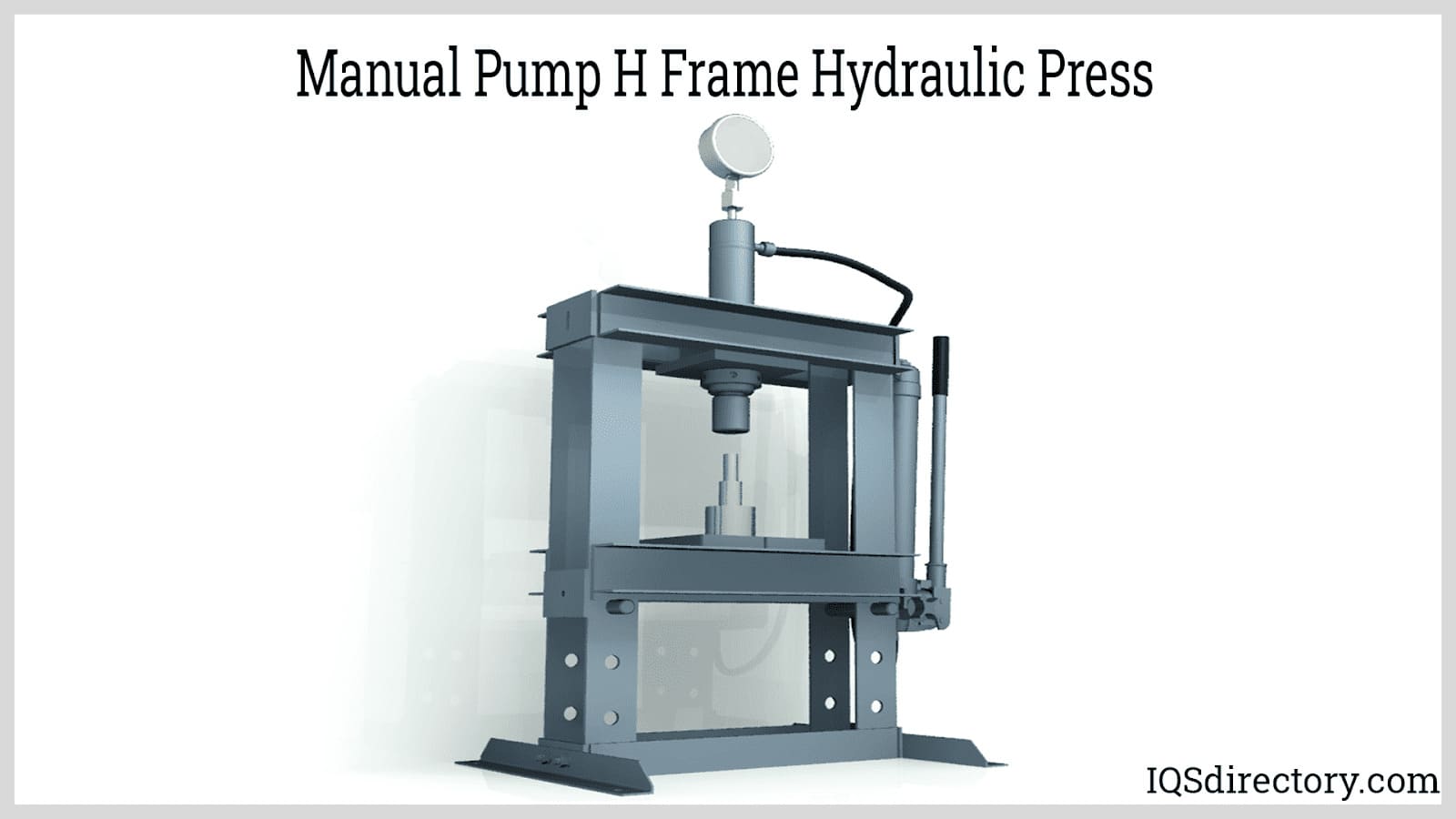 H frame presses can either be manual or automatic depending on the function.
H frame presses can either be manual or automatic depending on the function.
Types of Hydraulic Presses
- Arbor Presses
- Used for seating stamping and removing bearings and other high-pressure assembly, repair and production jobs.
- Assembly Presses
- Use great pressure to secure or assemble parts together.
- C-Frame Presses
- Streamlined-sized, press-shaped like a "C" and normally consist of a single press application.
- Compression Molding Presses
- Two plates being pushed together to compress the material into the mold.
- Forging Presses
- Hydraulically powered metal forming machinery that force metal blocks to take the shape of a product by using a mold, extreme force and pressure, and sometimes heat.
- Platen Press
- There are many different types of hydraulic press; each with its own set of applications, although there is some overlap. Those that use a ram and a solid, stable surface are categorized as platen presses.
- Hydraulic C-Frame Press
- Named for its c-shaped frame; this frame is narrow but sturdy, and allows the press to take up less floor space than others. As presses that can be designed for manual or automatic use, c-frame presses can be used for a variety of industrial operations including forming, straightening, blanking, punching, drawing and riveting.
- H-Frame Hydraulic Press
- Named after its frame as well; this one is a welded H-shape. H-frame presses, sometimes referred to as 4-column presses, are shaped like an "H" and can often field more than one press application at a time. Similar to C-frame presses, this type of press is used for industrial applications like coining, crimping, bending, punching and trimming. Unlike C-frames, though, H-frames are able to handle multiple operations.
- Extrusion Press
- A type of press that metalworkers and other manufacturers use to extrude parts and products. Extrusion pressing is a process during which the press pushes a die through a material in order to create a fixed cross-sectional profile.
- Laboratory Presses
- Smaller, single run presses used primarily in research laboratories and other short and test run situations.
- Laminate Press (Laminating Press)
- Manually operated compression presses with two openings, known as plates. One is used for heating and the other is used for cooling, thus making the lamination process faster as a result of the simultaneous cooling of one platen while heating the other. Laminating presses are used for the lamination of polymers onto the surface of other materials including lumber, metal and paper.
- LIM Presses
- Refers to liquid injection molding presses which handle plastics that are created via an injection process.
- Vacuum Press
- Have a few specialized applications, such as applying film to a variety of materials as well as encapsulating layers of materials in plastic for electronics industries, credit cards and identity cards.
- Stamp Press (Stamping Press)
- Much like laminating presses, have specialized applications, and are used for the two main purposes of shaping or cutting materials by deformation with a die for metalworking or automotive industries.
- Transfer Press
- Work by feeding flat plastic, rubber or metal blanks automatically into the right end of the press. From there, feed bar fingers take the part and move it from die to die. They are used for the stamping and molding of plastic, rubber and metal such as in the medical and aerospace industries.
- Press Brake
- Used to bend, fold or otherwise cold work sheet metal. It is typically formed from two C-frames at the sides, a movable beam at the top, and a bottom tool mounted to a table. A hydraulic press brake is differentiated from other press brake types by two synchronized hydraulic cylinders on the C-frames; they move the beam. When automated, this press type is known as a CNC press brake.
- Hydraulic Forge Press (Forging Press)
- Used only with metal. They force metal blocks into shapes using a closed or open mold, force, pressure, and sometimes heat. This combination stretches the metal past its yield point, without breaking or cracking it. Forge presses are most popular for use in vehicle manufacturing applications.
- Shop Press
- Used primarily in automotive repair. It can remove, repair and set bearings, bushings, u-joints, and more. It can also straighten bent parts. Consider a shop press for a small garage business.
- Non-Hydraulic Presses
- A standard industrial hydraulic press is a type of power press. Power presses can be pneumatic, hydraulic or mechanical. Alternatives to hydraulic presses include mechanical presses, electric presses and pneumatic presses.
- Mechanical Press
- Used to shear, punch, form or assemble materials by using tools or dies attached to slides or rams. Mechanical presses are driven by a flywheel which stores energy then releases it, thus transferring energy to the main slide by the use of mechanisms such as a crank, eccentric, knuckle joint or toggle. In a mechanical press, the stroke of the slide is adjustable within the limits of daylight. In addition, the strokes are also classified by the number of slides or ram they have, which can be single, double or triple action.
- All-Electric Press
- Fairly recent developments, offering more efficient drive systems due to the mechanical linkage of the ram with the drive motor. This ensures that the controller is able to give a signal to the motor for a specific speed. If the motor is not overloaded then that speed will be reached. Also, the elimination of hydraulic fluid variations is beneficial because hydraulic fluid changes across time and temperatures, they can even vary within a single day.
- Pneumatic Press
- Serve applications similar to hydraulic presses, including piercing, metal working, crimping, stamping, bending and punching. They can have stroke cycles of up to 400 strokes per minute, or SPM. Even at high stroke speeds, pneumatic presses are able to offer a controlled flow rate that makes them ideal for applications in which the material flow rate, or ram velocity, is crucial. Pneumatic presses do not convert rotary motion to linear motion and therefore have fewer moving parts than hydraulic press or machine presses. However, pneumatic presses use compressed air in order to gain movement and are not capable of creating the extremely high pressures of hydraulic presses.
- Platen Presses
- Large, industrial hydraulic presses that use two large, heated steel plates to crush, condense, mold and form different products.
- Power Presses
- Hydraulic powered machines that use tools and dies to shear, punch, and form metals.
- Press Brakes
- Manual, mechanical or hydraulic pressing machines that cold work sheet metal into different bent or folded shapes. See here for a press break calculator.
- Stamping Presses
- Devices that use stamping dies.
- Straightening Presses
- Apply pressure to metal in order to straighten it.
- Tableting Presses
- Used for the pressing of powdered materials into shaped tablets or compacts.
- Transfer Presses
- Hydraulic presses which automatically move parts from one stamping process to another using feed bar fingers.
- Vacuum Presses
- Hydraulically powered industrial systems that use air pressure to provide necessary force and air removal needed for laminating applications.
System Equipment Components of Hydraulic Presses
Consisting of the main components used in a hydraulic system, the basic form of a hydraulic press consists of a set of double-acting cylinders, pistons, also called punches, hydraulic pipes and a stationary anvil, or die.
One cylinder is small, while the other is large. The pair is referred to respectively as the slave cylinder and the master cylinder. The pistons are mechanical devices that provide a plunging or thrusting motion. Finally, the anvil, or die, is the preformed piece that gives a substrate its final shape.
Design and Customization of Hydraulic Presses
Most machinery is designed to handle extremely heavy loads, measured by the ton. However, hydraulic press manufacturers have a lot of control over this and can design presses to handle all load sizes. For example, while they can design presses able to handle 3500-ton load limits, they can also design machines with as small as 15-ton load limits.
Press machines are typically constructed from stainless steel and other durable materials like high strength steel alloys, aluminum and brass.
They are available in both single and multi-station configurations. Single station presses consist of a single set of press tools, a die and punch, inside of a table. Multi-station presses have multiple sets of press machine tools, which either perform the same operation on many materials, or perform various press operations on materials as they move between stages.
To customize your machine, manufacturers can alter press ton limit, increase or decrease length down to the mm, increase or decrease folding down to the mm, die shape, hydraulic fluid type, and more.
Things to Consider When Purchasing a Hydraulic Equipment
Maintenance plays a big role in keeping hydraulic equipment running optimally and efficiently. To keep your machine in great shape, consider the following preventative measures.
- Don’t Allow Leaks
- It’s a fact that a leaky machine performs way below the capacity. For the best results, your operator should routinely check for leaks around the O-ring seals, the ram of the press, hydraulic lines, hose end fittings and valve seats.
- Don’t Exceed Load Limits
- This one is pretty simple; don’t apply a heavier ton load than your press is designed to handle. If you exceed your ton hydraulic press limit, you risk causing undue stress on your machine, breakage, or even injury to workers.
- Keep a Well-oiled Machine
- For smooth functioning and reducing wear and tear, hydraulic machines should be lubricated sufficiently, especially around seals. Also, make sure that the hydraulic fluid you’re using is the same type specified in the operator manual.
- Check Pressure Build-up Speed
- A press in good condition can build working pressure in half to one second. Alternatively, if a press takes more than more than two to three seconds to build preset pressure, the press has an issue with either the pump or the relief valve. Mostly, the problem is associated with the pump revolving an insufficient amount of times per minute. The occasional problems associated with valves include dirt in the line and too wide of an opening.
- Listen for Unfamiliar Machine Sounds
- You must promptly investigate any unfamiliar sound, find the source and rectify it. The most common source of banging noises during press operation is valve shifts. Noises are also sometimes caused by insufficient lubrication.
- Check Electronic Machine Elements
- The most common electronic problems with hydraulics presses have with coils and relays. Note that their life cycle is finite, and they must be replaced from time to time. (Coils have a life cycle of 3 million strokes, and relays are designed for 1 million strokes.) Replacement reduces troubleshooting effort and downtime. When you do so, you should keep records using an hour meter and a non-resettable cycle counter, as they help in maintenance of the machine.
- Check Other Machine Elements
- Other things that you have to care about are fittings, loose wires and hoses, as frayed hoses and incorrect crimped fittings can lead to plumbing failures in any machines.
- Maintain Oil and Temperature During Operation
- The easiest way to extend the life of hydraulic presses is to maintain oil and its temperature during operation. If running a press machine while it has a low oil level and /or dirty oil, you risk harming it or shortening its operation life. The best way to ascertain the presence of dirt in oil is to perform oil samplings. If the oil has dirt particles in it, you should change the filter. Ideally, the operational temperature of a press is around 120?; if it gets higher than that, the operation starts to break down. To maintain the optimum temperature, use air and water coolers. Make sure to maintain these units properly, especially the radiator, which tends to attract dirt.
- For the best results from start to finish, make sure to work with a reputable hydraulic press manufacturer you can trust. Unfortunately, there are a lot of subpar manufacturers out there, masquerading as quality suppliers. Eliminate the confusion and the riffraff by going with manufacturer names provided by a proven directory, such as this one. For your convenience, we’ve provided a list of great manufacturers above. Check out their websites, pick a few you like, and, when you’re ready, reach out to them with your specifications. To make your decision, compare and contrast their stats, answers, and the overall feel of their customer service. That way, you’re sure to find the right one for you.
Hydraulic Press Terms
- Actuator
- A device that converts fluid power into mechanical movement.
- Age
- The amount of time necessary to wait between the molding and appraisal of molded part properties.
- Backrind
- A defect at the parting line where the material has shrunk inside the part.
- Bed
- The flat surface that supports the material being worked.
- Bolster
- Plates attached to the rods that carry the platens or any structure mounted to the bed of a press. It is sometimes removable.
- Check Valve
- Any one of several types of valves that allows flow in only one direction.
- Compression Set
- The lingering deformation after removal of the force, which compressed the section. An example is when one uses a fingernail to depress a molded sample; the impression that remains after a time is the compression set.
- Contact Gauge
- A feature of hydraulic systems that turns the system off and on at set pressure points.
- Cylinder Assembly
- The cylinder, piston, ram, seals and packing of a press.
- Daylight
- The largest capacity, vertically, that the press can handle or the vertical clearance from the underside of the ram to the top of the bolster. The ram must be in its maximum up position.
- Die
- The tooling used in a press for shearing, punching, forming, drawing or assembling metal or other materials.
- Gate
- The final opening through which injected material flows in order to enter a part cavity.
- Heat Exchanger
- Circulates air or water to maintain oil at operating temperature.
- Hydraulic Pressure
- Pressure caused by fluid under applied force.
- Hydraulic Cylinders
- Actuation devices that produce linear motion and force through the use of pressurized hydraulic fluid.
- Hydraulic Pump
- Pumps that use mechanical energy to deliver high-pressure fluid flow to the outlet through pressurized fluid.
- Hydraulic Seals
- A device that restricts the escape of fluid or entrance of foreign material.
- Hydraulic Valves
- A device that contains and transfers the flow and pressure of hydraulic fluid in hydraulic power systems.
- Knockout
- Removes the part from the punch/die.
- Low Pressure System
- A press function that allows it to operate continuously under 10% of its maximum rated force, as well as to ensure a preheat function at reduced pressure.
- Platen
- The place where the mold attaches. It is a series of flat surfaces where one surface is stationary and the other is moving.
- Rod or Tie Rod
- Long stem or pole that connects two pieces of the press so that they act together.
- Shut Height
- With the ram full down, it is the clearance over the bed.
- Sprue
- The main feed guide that runs from the outer face of an injection or transfer mold gate into a single cavity mold or to runners in a multiple cavity mold.
- Stroke Control
- Feature that controls the length of a stroke and can be adjusted accordingly.
- Throat Clearance
- Distance between the frame member behind the bed to the vertical centerline of the ram. This measurement affects the size of the piece that can be used.